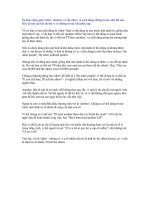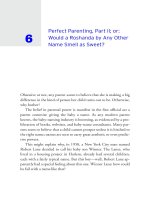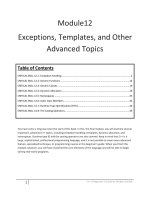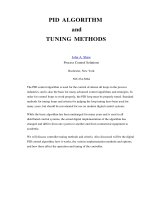Other reversible methods potx
Bạn đang xem bản rút gọn của tài liệu. Xem và tải ngay bản đầy đủ của tài liệu tại đây (95.83 KB, 10 trang )
134
BARRIER METHODS
Barrier methods are not yet out of fashion! In spite of well-known
disadvantages, they all (notably condoms) provide useful protec-
tion against STIs. All users of this type of method should be
informed about EC, in case of lack of use or failure in use.
Vegetable- and oil-based lubricants, and the bases for many
prescribable vaginal products, can seriously damage and lead
to rupture of rubber: baby oil destroys up to 95% of a condom’s
strength within 15 minutes. Beware ad hoc use of, or contami-
nation by, substances from the kitchen or bathroom cupboard!
Water-based products such as KY Jelly, and also glycerine and
silicone lubricants, are not suspect. The box on p. 135 lists some
common vaginal preparations that should be regarded as unsafe
to use with rubber condoms and diaphragms – and there may
be others.
This problem does not affect plastic condoms such as Avanti and
Ez-On (see below). However, there is no evidence that either of
these is any less likely to rupture for mechanical reasons.
Other reversible methods*
*Male and female sterilization – especially the former, which is more effective –
are useful options for some couples, but are not within the remit of this particular
book.
all job 14/5/07 8:44 am Page 134
135
Condoms
Condoms are the only proven barrier to transmission of HIV –
yet, at the time of writing, it still remains impossible in the UK
for most couples to obtain this life-saver free of charge from
every GP. Condoms are second in usage to the Pill among
those under the age of 30 and to sterilization above that age.
One GP has reported a failure rate as low as 0.4 per 100
woman-years, but 2–15 is more representative. Failure, often
unrecognized at the time, can almost always be attributed to
incorrect use – mainly through escape of a small amount of
semen either before or after the main ejaculation. Conceptions
– particularly among the young or those who have become a bit
casual after years of using a simple method such as the COC
– can sometimes be iatrogenic because of lack of explanation
by a nurse or doctor of the basics.
Some users are entirely satisfied with the condom, whereas
others use it as a temporary or back-up method. For many who
have become accustomed to alternatives not related to inter-
course, it is completely unacceptable. Some older men, or those
with sexual anxiety, complain that its use may result in loss of
erection. I consider this sometimes gives adequate grounds to
prescribe sildenafil. For women who dislike the smell or messi-
ness of semen, the condom solves their problem.
True rubber allergy can also occur (rarely), but is often solved
by switching to plastic condoms (e.g. Avanti or Ez-On). If the
allergy proves to be to the lubricant, if it contains nonoxinol-9, it
Preparations unsafe to use with rubber condoms or diaphragms
Arachis oil Gyno-Pevaryl (Janssen-Cilag)
Baby oil Lomexin (Akita)
Canesten (Bayer) Nizoral (Janssen Cilag)
Cyclogest Nystan cream (Bristol-Myers
(Shire Pharmaceuticals) Squibb) (pessaries okay)
Dalacin cream Ortho-Gynest (Janssen-Cilag)
(Pharmacia & Upjohn) (Organon laboratories)
E45 and similar emollients Petroleum Jelly
Ecostatin Sultrin (Janssen-Cilag)
(Bristol-Myers Squibb) Vaseline (Elida Fabergé)
Gyno-Daktarin (Janssen-Cilag) Witepsol-based preparations
all job 14/5/07 8:44 am Page 135
136
should not be being used in the first place. Lubricants with this
spermicide should be avoided with any condom, since there is
now evidence that it can increase HIV transmission (see below)
– and, anyway, it provides no detectable increase in condom
efficacy.
The Ez-On condom and its variants
Available in California and the Netherlands (and hopefully soon
in the UK), this is a loose-fitting well-lubricated plastic condom
– the ‘looks funny, feels good’ condom. In some respects, it is
the concept of the female condom ‘put back on the man’. By a
better simulation of the normal vagina, it is designed to
overcome the undeniable interference with penile sensation that
occurs during the penetrative phase of intercourse.
Femidom
Femidom (Figure 17) is a female condom comprising a
polyurethane sac with an outer rim at the introitus and a loose
inner ring, whose retaining action is similar to that of the rim of
the diaphragm. It thus forms a well-lubricated secondary vagina.
Available over the counter, along with a well-illustrated leaflet, it
is completely resistant to damage by any chemicals with which it
Figure 17
The female condom (Femidom). (Reproduced with kind permission of Chartex
International plc.)
all job 14/5/07 8:44 am Page 136
might come into contact. Using it, the penetrative phase of inter-
course can feel more normal (as with Ez-On) and also start before
the man’s erection is complete. However, couples should be
forewarned of the possibility that the penis may become wrongly
positioned between the Femidom sac and the vaginal wall.
Reports about its acceptability are mixed, and a sense of humour
certainly helps. There is evidence of a group of women (and their
partners) who use it regularly, sometimes alternating with the
male equivalent (‘his’ night then ‘her’ night). Others might choose
it if it were more often mentioned by providers as even being an
option. As the first female-controlled method with high potential
for preventing HIV transmission, it must be welcomed.
The cap or diaphragm
Once initiated, many couples express surprise at the simplicity
of these vaginal barriers, although they are often acceptable
only when sexual activity takes on a relatively regular pattern in
a stable relationship (and nowadays usually above age 35). The
cap may be inserted well ahead of coitus, and so used without
spoiling spontaneity. There is very little reduction in sexual
sensitivity, as the clitoris and introitus are not affected and cervi-
cal pressure is still possible.
Spermicide is recommended because no mechanical barrier is
complete, although we still lack definitive research on this point.
Possible toxic effects of nonoxinol-9 – which is unfortunately the
only spermicidal agent marketed in UK – to the vaginal wall have
become a real concern (see below). However, the vagina is
believed to be able to recover between applications when
nonoxinol-9 is used in the manner, and at the kind of average
coital frequency, of typical diaphragm-users.
The acceptability of the diaphragm itself depends on how it is
offered. Its first-year failure rate, now estimated as high as 4–8
per 100 careful and consistent users, rising to 10–18 per 100
typical users, makes it very unsuitable for most young women who
would not accept pregnancy. However, it suits others who are
‘spacers’ of their family. And it is capable of excellent protection
above the age of 35 (3 per 100 woman-years, as the Oxford/FPA
137
all job 14/5/07 8:44 am Page 137
study reported in the early 1980s), provided it is as well taught
and correctly and consistently used as it was by those couples.
Lea’s Shield and Femcap are both American inventions. The
latter has some efficacy data; the reported Pearl failure rate is
comparable with that of the diaphragm: 10.5–14.5 per 100
woman-years. It is a plastic cervical cap with a brim filling the
fornices, in three sizes, intended to be provided through
mainstream clinics (supplier: Durbin) as an alternative to the
diaphragm or cervical caps. It must be used with a spermicide,
but is reusable, needing to be replaced about every 2 years.
When there is great difficulty in inserting anything into the vagina
– be it tampon, pessaries or a cap – the method is obviously
not suitable. This problem may be connected with a psycho-
sexual difficulty that may first present during the teaching of the
method, but simple lack of anatomical knowledge is often
involved. Rejection of a vaginal barrier on account of ‘messi-
ness’ may also be the result of such a problem.
Follow-up
Vaginal barriers should be checked initially after 1–2 weeks of
trial, then annually. The fitting of diaphragms should be re-
checked routinely postpartum, or if there is a 4 kg gain or loss
in weight.
If either partner returns complaining that they can feel any kind
of cap during coitus, the fitting must be urgently checked. It
could be too large or too small; or with the diaphragm the retro-
pubic ledge may be insufficient to prevent the front slipping
down the anterior vagina; or, most seriously, the item may be
being placed regularly in the anterior fornix. The arcing spring
diaphragm is then particularly useful.
Chronic cystitis may be exacerbated by pressure from a
diaphragm’s anterior rim, and the condition was shown to occur
less frequently with Femcap in the comparative pre-marketing
trials. Similarly, it often improves with a vault or cervical cap.
As for the IUD, for those nurses or doctors who wish to offer
this choice, there is no substitute for one-to-one training, both
138
all job 14/5/07 8:44 am Page 138
in the process of fitting the diaphragm and cervical caps and in
teaching a woman how to use it correctly, backed by an appro-
priate leaflet.
With each of these products, the single most important thing the
woman must learn is the vital regular secondary check, after
placing it, that she has covered her cervix correctly. Female
barriers can be used happily and very successfully by many
couples, but high motivation is essential. Once again, a good
sense of humour helps.
Spermicides
Sadly, many useful products such as Delfen foam and Gynol II
jelly have now been removed from the UK market. At the time
of writing, the only products available are Orthoform pessaries
and Ortho-Creme™ for use with diaphragms. However, the
contraceptive sponge is apparently due back on the market in
2007 as the Today sponge – for details visit www.todayswom
-
encare.com). It has the advantages of being sexually very
convenient and unobtrusive in use.
Although invaluable as adjuncts to caps and diaphragms, used
alone spermicides are usually not acceptably reliable. Yet
spermicides and sponges can be used successfully by women
whose natural fertility is reduced, particularly with increasing age.
The Today sponge, or other spermicidal products may be good
choices in the following cases:
• For women over 50 years of age if still experiencing bleeds after
stopping the COC (see pp. 147); and for 1 year after the
menopause (when contraception is still advised), whether or not
they use HRT
• For women aged over 45 if they have oligo-amenorrhoea
• During lactation as an alternative to the POP
• During continuing secondary amenorrhoea, unless a COC is
being used anyway to treat hypoestrogenism
• As an adjunct to other contraception – e.g. spermicides may be
useful as a supplement in couples who choose to continue using
withdrawal as their main method
• For ‘spacers’, nearly but not quite ready for a first or subsequent
child.
139
all job 14/5/07 8:44 am Page 139
140
Many substances are well absorbed from the vagina, but there
is no proof of systemic harm, congenital malformations or
spontaneous abortions from the use of current spermicides,
chiefly nonoxinol-9 or its close relatives.
Occasionally, sensitivity to a spermicide arises. More seriously,
when used by Nairobi prostitutes four times a day for 14 days,
nonoxinol-9 released from pessaries caused erythema and
colposcopic evidence of minor damage to the vaginal skin.
Coupled with the doubts about its effectiveness against intra-
cellular virus, it clearly should not be promoted as an anti-HIV
virucide (see the systematic review by D Wilkinson et al Lancet
Inf Dis 2002; 2: 613–17). However, pending better alternatives,
for the time being it remains good practice to continue to recom-
mend nonoxinol-9 for normal contraceptive use (less frequently
than four times a day!), whether alone or with diaphragms or
cervical caps; but not with condoms.
Final comment
Worldwide, there remains a great unmet need for an effective user-
friendly female-controlled vaginal microbicide, which might or might
not also be a spermicide. Many international agencies are now
actively involved, but progress is slow in this urgent and previously
neglected area of research.
FERTILITY AWARENESS AND METHODS FOR
NATURAL REGULATION OF FERTILITY
At one time, these methods were generally despised and only
adopted by those with strong religious views. Modern multiple
index versions (based primarily on carefully charting changes to
cervical mucus, the cervix itself by auto-palpation, and body
temperature, with support from the so-called secondary indica-
tors such as ovulation pain) are increasingly demanded by those
who prefer to use a more ‘natural’ method. There is no space
here to do justice to this approach, but there is a website that
is uniquely good among all those in the area: www.fertilityuk.org
.
It is completely neutral. Indeed, it makes the following excellent
comment regarding other information sources: ‘NFP [natural
family planning] instruction often comes with a religious orienta-
tion that you may or may not appreciate’.
all job 14/5/07 8:44 am Page 140
Those who wish to use these methods deserve careful expla-
nation and ideally one-to-one teaching, particularly about chart-
ing the cyclical changes and the possible added use of other
minor clinical indicators of fertility. Useful instruction leaflets,
further advice and details of NFP teachers (mostly non-NHS)
available in different localities, can be obtained from www.fertil
-
ityuk.org (and also from the FPA website, www.fpa.org.uk
).
Additionally they give advice about fertility awareness to assist
conception.
With ‘perfect use’, the multiple index methods are indeed
capable of being acceptably effective. However in the words of
Professor Trussell of Princeton, they still remain ‘very unforgiv-
ing of imperfect use’. Moreover, imperfect use is unfortunately
common in the real world. To be effective, many days of absti-
nence are inevitable and the highest possible cooperation from
both parties is required but often lacking – especially from the
male, whose motivation may well be suspect. (In one study, the
failure rate was noted to be higher when the man rather than
his partner was the one in charge of interpreting the tempera-
ture charts!) To be fair to the methods, failures also commonly
result from poor use of other contraceptives, such as the
condom, by those who do not wish to abstain during ‘unsafe’
days.
Persona (Unipath Ltd) (Figure 18) is a combination of mini-
laboratory and microcomputer, Persona displays the ‘safe’
(green) and ‘unsafe’ (red) days of a woman’s cycle, based on
measurements of the first significant rise in her levels of urinary
estrone-3-glucuronide and luteinising hormone. With a reduced
number of ‘unsafe’ days (8–10 for most women) being signalled
per cycle, this contraceptive option is found by many couples to
make things easier – but it does not apparently lead to greater
effectiveness than careful charting of the indices with good
compliance. The data on the failure rate are reported as 6 per
100 woman-years in the first year even with ‘perfect use’ – and
Trussell (personal communication, 2003) still considers this to
be an underestimate.
Even on that slightly uncertain basis, couples should be
informed that this is the same as a 1 in 17 risk of conceiving in
141
all job 14/5/07 8:44 am Page 141
142
the first year – perhaps good enough for ‘spacers’.
For greater efficacy, couples should be advised:
• to use condoms on the pre-ovulatory ‘green days’ – this being
what I would prefer to call the ‘amber’ phase (always less ‘safe’
because of the capriciousness of sperm survival in a woman)
• to abstain completely on all ‘red days’
• to have unprotected intercourse only in the post-ovulatory green
phase.
Moreover, if Persona or another natural method is to be
commenced after any pregnancy or any hormone treatment –
even just one course of hormonal EC – reliability demands that
another method such as condoms or abstinence must first be
used until there have been two normal cycles of an acceptable
length (23–35 days).
Lactation within the specific guidelines of the lactational
amenorrhoea method (LAM) as shown in Figure 19 constitutes
a quintessentially ‘natural method’ – through to 6 months
postpartum. See also p. 70.
Figure 18
Persona (by courtesy of Unipath Ltd).
all job 14/5/07 8:44 am Page 142
143
Are you amenorrhoeic
(no vaginal bleeding after
56 days after the birth)?
a
Ask the mother:
There is only about a 2%
chance of pregnancy. You do
not need a complementary
family planning method at this
time
Your chance of
pregnancy is increased.
You should not rely on
breastfeeding alone.
Use another family
planning method, but
often continue to
breastfeed for the
child’s health
Is your baby less than 6
months old?
Are you fully or
nearly fully
b
breastfeeding
your baby?
When the answer to any one
of these questions becomes
NO:
Figure 19
Algorithm for the lactational amenorrhoea method (LAM)
NO
NO
NO
YES
YES
YES
a
Spotting that occurs during the first 56 days is not considered to be
menstruation
b
‘Nearly’ full breastfeeding means that the baby obtains almost 100%
of its nutrition from the mother alone, and certainly no solid food
all job 14/5/07 8:44 am Page 143









